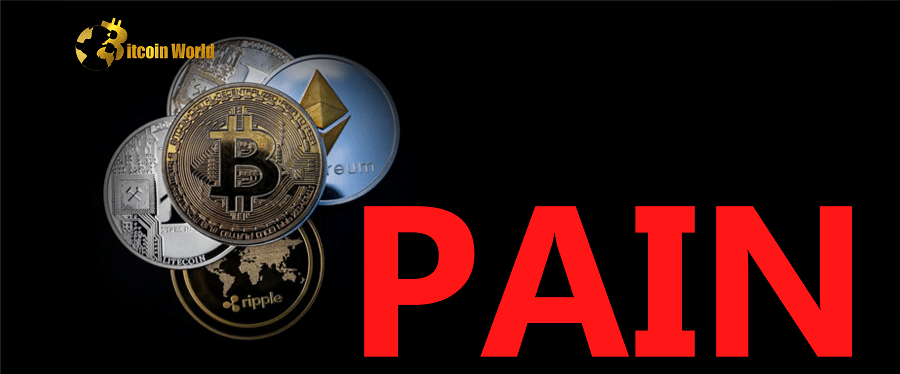The chances of a crypto bull market in 2023 are decreasing as the Fed maintains its hawkish stance and threats of a recession in the US economy persist.
Without a doubt, 2022 was one of the worst years for Bitcoin buyers, owing to a 65% drop in the asset’s price. While there were some explicit reasons for the drop, such as the LUNA-UST crash in May and the FTX implosion in November, the most important reason was the United States Federal Reserve’s tapering and interest rate hikes.
Because of the Fed rate hikes, Bitcoin’s price had dropped 50% from its peak to lows of $33,100 before the LUNA-UST crash. The first significant drop in Bitcoin’s price was caused by growing market uncertainty surrounding rumours of a rate hike in November 2021. By January 2022, the stock market had already begun to crack due to the increasing pressure of impending tapering, which had a negative impact on cryptocurrency prices.
Fast forward a year, and the crypto market is still dealing with the same issue, with headwinds from Fed rate hikes limiting significant bullish moves. Worse, this regime may last much longer than market participants anticipate.
The 1999-2000 dot-com bubble could teach investors a lot about the current crypto winter, and it continues to paint a bleak picture for 2023.
By the early 2000s, the Nasdaq Composite had inflated to enormous levels, and this bubble burst when the Fed began raising interest rates in 1999 and 2000. As credit became more expensive, the amount of easy money in the market shrank, causing the Nasdaq to fall 77% from its peak.
The crypto market is currently experiencing the same situation.
Fed Chairman Jerome Powell is determined to keep inflation under control, which means higher interest rates for the foreseeable future. Minneapolis Federal Reserve President Neel Kashkari recently stated in a blog post that he expects terminal rates to rise to 5.4% by June 2023 — rates are currently in the 4.25% to 4.50% range.
Notably, during the dot-com bubble, the Fed stopped raising interest rates in May 2000, but the Nasdaq continued to fall for the next two years. As a result, we can expect the crypto market to fall further until the Fed pivots. If the US economy experiences a recession similar to that of 2001, the current bear market could last even longer.
According to Mises Institute analyst Ryan McMaken, the US dollar’s M2 money supply will be negative in November 2022 for the first time in 28 years. It is a warning sign of a possible recession, which is usually “preceded by slower rates of money supply growth.”
While McMaken acknowledged the possibility of the negative money supply growth indicator turning into a false signal, he added that it “is generally a red flag for economic growth and employment. It also serves as yet another indication that the Federal Reserve’s promised “soft landing” is unlikely to ever become a reality.”
According to the most recent Institute of Supply Management report, US economic activity contracted for the second consecutive month in December. The purchasing managers’ index (PMI) was 48.3% in December, with values below 50% indicating contraction. It implies that demand for manufactured goods is declining, most likely as a result of higher interest rates.
Since 1857, the average U.S. recession has lasted 17 months, with six recessions lasting less than ten months since 1980. This recession technically began in August 2022, with two-quarters of GDP growth being negative. According to historical averages, the current recession could last until June 2023 to January 2024.
The crypto market requires the realm of easy money to return in order to build a long-term bull run. However, based on the Fed’s current strategy, those conditions appear to be a long way off.
Only a black swan event, such as the COVID-19 pandemic, can cause the US government to resort to quantitative easing with low interest rates and economic stimulus, as it did during the COVID-19 pandemic.
According to independent market analyst Ben Lilly, a bubble may be forming in the consumer loan sector, which has grown exponentially to nearly $1 trillion in the last decade.
The increase has been especially sharp in the last two years, since the US government stopped writing stimulus checks. Lilly speculates that the sector could implode if many borrowers default on their loans as the economy continues to deteriorate. He also stated that “government stimulus will be required to solve.”
One of the most difficult things to predict is the timeline for a bubble burst. It could possibly coincide with the end of the recession in late 2023 or 2024. Nonetheless, most investors expect the crypto markets to remain in a downtrend until a Fed pivot or quantitative easing is confirmed.
Since its peak of $3 trillion in 2017, the total crypto market capitalization has fallen by 75%. The market’s 2017 peak of around $750 billion is a critical support and resistance level. If this level is breached, the total market capitalization of the industry could fall below $500 billion.
While temporary bear market rallies may occur, macroeconomic pressures are likely to undermine any positive moves.














